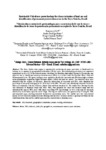Por favor, use este identificador para citar o enlazar este ítem:
http://www.alice.cnptia.embrapa.br/alice/handle/doc/951532Registro completo de metadatos
| Campo DC | Valor | Lengua/Idioma |
|---|---|---|
| dc.contributor.author | HOFF, R. | pt_BR |
| dc.contributor.author | FARIAS, A. R. | pt_BR |
| dc.contributor.author | BUFFON, E. C. | pt_BR |
| dc.contributor.author | TORRI, R. M. | pt_BR |
| dc.date.accessioned | 2013-02-27T11:11:11Z | pt_BR |
| dc.date.available | 2013-02-27T11:11:11Z | pt_BR |
| dc.date.created | 2013-02-27 | pt_BR |
| dc.date.issued | 2012 | pt_BR |
| dc.identifier.citation | In: SYMPOSIUM SELPER, 15., 2012, Cayenne. Proceedings... [S.l.: s.n.], 2012. | pt_BR |
| dc.identifier.uri | http://www.alice.cnptia.embrapa.br/alice/handle/doc/951532 | pt_BR |
| dc.description | The Serra Gaúcha wine region is important for production of grapes and wines in Brazil and it is looking for recognition by geographical indications (GI) for wines. Environmental preservation is an important requirement to set a GI. In the research project developed by Brazilian Agricultural Research Corporation, one objective was to identify permanent preservation areas (PPA) in accordance with the Brazilian Forest Code and Environmental Laws. The geotechnologies were applied to identify the vineyards into PPA from high resolution aerial photographs to generate digital elevation model (DEM) and land use survey. The vineyards areas were obtained from the register of vineyards. From the intersection of vineyards and PPA, were identified the percentage of vineyards belonging to the GI located in the PPA. This work was identifying vineyards located in PPA areas within the Vale dos Vinhedos, Monte Belo and Pinto Bandeira GI. The studies were developed in the GIS laboratory of Embrapa Grape and Wine. First, were prepared the slope and distances maps and was elaborated the map of PPA, areas with slopes exceeding 47% and drainage, as well as the map of vineyards obtained by vectorization upon the aerial image. The map of conflict areas was generated by crossing the PPA and vineyards maps, showing vineyards deployed in conservation areas. The conflict area was characterized mostly by few vineyards deployed across drainage and the three GI areas showed a good preservation for the cultivation of the vine and the conflict areas must be converted in reclamation areas. | pt_BR |
| dc.format | 1 CD-ROM. | pt_BR |
| dc.language.iso | por | pt_BR |
| dc.rights | openAccess | pt_BR |
| dc.subject | Geotecnologia | pt_BR |
| dc.subject | Indicação geográfica | pt_BR |
| dc.subject | Viticultura sustentável | pt_BR |
| dc.subject | Área de preservação permanente | pt_BR |
| dc.title | Sustainable Viticulture: geotechnology for characterization of land use and identification of permanent preservation areas in the Serra Gaúcha, Brazil. | pt_BR |
| dc.type | Artigo em anais e proceedings | pt_BR |
| dc.date.updated | 2017-01-11T11:11:11Z | pt_BR |
| dc.subject.thesagro | Viticultura | pt_BR |
| dc.subject.thesagro | Uva | pt_BR |
| dc.subject.thesagro | Sensoriamento remoto | pt_BR |
| dc.subject.thesagro | Meio ambiente | pt_BR |
| dc.format.extent2 | p. 1-8. | pt_BR |
| riaa.ainfo.id | 951532 | pt_BR |
| riaa.ainfo.lastupdate | 2017-01-11 | pt_BR |
| dc.contributor.institution | ROSEMARY HOFF, CNPUV; ANDRE RODRIGO FARIAS, CNPUV; ELIEGE CASSIELE BUFFON, UFSM; RAFAEL MUNARI TORRI, ADEGA TORRI. | pt_BR |
| Aparece en las colecciones: | Artigo em anais de congresso (CNPUV)  | |
Ficheros en este ítem:
| Fichero | Descripción | Tamaño | Formato | |
|---|---|---|---|---|
| FPSELPER049.pdf | 1.88 MB | Adobe PDF |  Visualizar/Abrir |









